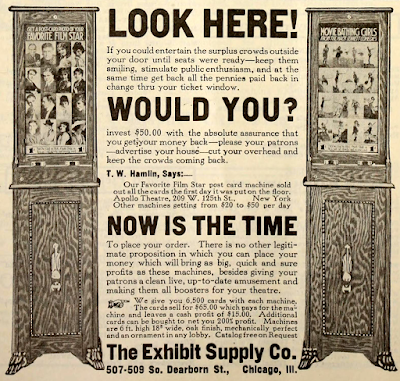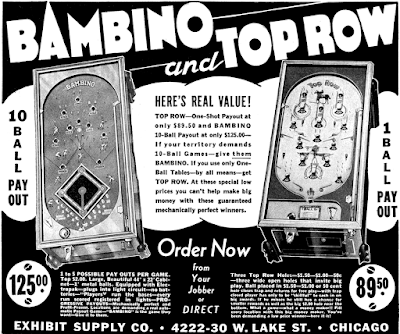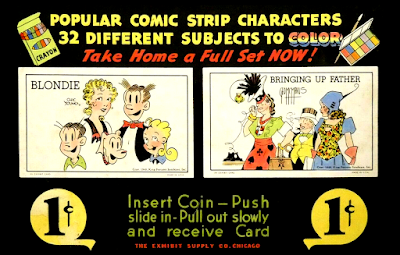ESCO : The Exhibit Supply Company
The Exhibit Supply Co. Theatorium was originally located in the downtown "Diamond" area of East Liverpool, Ohio. In 1906, the company advertised film equipment and various electrical components. John Franklin Meyer founded the Meyer Printing Company in Chicago in 1901. "Frank" Meyer partnered with the Exhibit Supply Co. in 1907, printing theater lobby displays and arcade vending cards.
The first post cards from ESCO, commonly referred to as Exhibits,
were advertised at $1.75 per thousand cards. The cards were randomly
dispensed from vending machines for a penny each. The original 1907
catalogue included Cupid Love Letters, Horoscope Cards, Palm Letters, Puss
in Boots, and Stereoscopic Views.
Frank Meyer became sole owner of Exhibit Supply Co. in 1910. By 1914, ESCO distributed slot machines, peep shows, and various coin-operated amusements.
Meyer received royalties on patented game machines from a wide variety of
manufacturers, including competitors.
ESCO vending machines were designed to dispense official Exhibit cards,
printed every 30 days. In 1919, the Favorite Film Star machine sold
out during the first day on the floor of the Apollo Theater in Harlem. The
early photo cards included Movie Bathing Girls, featuring the Mack
Sennett Bathing Beauties.
The first Exhibit cards to feature professional boxers and baseball players
were released in 1921. The 2011 Baseball series from The Topps
Company includes a reprint of the 1921 Babe Ruth Exhibit. According to
Topps, the baseball Exhibits "marked the first time the card itself was
the product to purchase rather than a supplement or advertisement for a
different commodity." From 1886–1930, baseball cards were commonly packaged
with tobacco products or candy. The trend shifted to bubble gum following the introduction
of Dubble Bubble from the
Frank H. Fleer Corporation.
In 1925, Exhibit Supply filed a lawsuit against Louis Hurwitz and the United
Post Card Company in Philadelphia. Hurwitz printed post cards that were
designed to fit in ESCO machines. In 1927, the court ordered Hurwitz to
print "Not to be used in Exhibit machines" on each card.
In June 1936, ESCO released Bambino, a baseball game that
dispensed a prize ticket for every winning combination. The ticket mechanism
and 10-ball game was designed to sell in territories that restricted
gambling.
During World War II,
machinery production was diverted to the Allied effort. ESCO manufactured
submarine radar equipment and various mechanical parts for the U.S.
military. Meyer personally oversaw the development of an electro-snap switch
to operate airplane weapon bay doors. Following the war, production
continued under a separate division as the Electro-Snap and Switch
Manufacturing Company.
The first pinball machine to feature flippers was Humpty Dumpty,
released by D. Gottlieb & Co. on October 25, 1947. In March 1948, ESCO
began marketing flipper conversion kits for older pinball games. In July
1948, the ESCO Chicago plant production area was doubled on West Lake
Street. In November 1948, ESCO announced Morocco, a pinball machine
featuring flippers and electrical kickers.
ESCO released the
King Feature Comics
series in 1949. The set features the first Superman arcade vending card. The
black-and-white comic Exhibits are lithographed on thick cardstock suitable
for watercolor painting. The King Feature Comics series was
distributed as late as 1955.
John Franklin Meyer passed away on November 9, 1948, at Huntington Sanatorium in Pasadena, California. Trade representatives from around the country attended the funeral service in Oak Park, Illinois.
ESCO was the largest manufacturer of card vending machines during the first
half of the twentieth century. The company printed over 14,000 different
cards for a wide variety of subjects that included airplanes , missiles , and astronauts . ESCO produced about 390 different arcade games
and coin-operated amusements.
In the 1950s, gum manufacturers
Bowman, Fleer, and Topps began aggressively competing over licensing rights for athletes
and celebrities. ESCO plant manager Chester Gore became company president in
1957, and sole owner in 1960. By 1964, Topps had signed nearly every active
baseball player. Topps forced ESCO to stop printing players with exclusive contracts in 1966 and the last ESCO card vending machines were manufactured
that year. Exhibit cards continued to be printed as needed to fill orders. Chester Gore reprinted cards from Baseball's Great Hall of Fame in
1974 and 1977.
In 1977, ESCO was sold to trading card dealer Paul Marchant. The archive included 7,000 photos that Merchant later sold at auction. Various ESCO machines were converted to accept quarters before the entire inventory was
sold. The last cards issued by Exhibit were two Baseball's Great Hall of Fame sets in 1980. ESCO was dissolved in 1985.
-
The TV and Radio Stars series was distributed throughout the 1940s
and 1950s. The American Card Catalog reference is W409. The TV and Radio Stars printings are categorized by variations of the "Made in U.S.A." font.
According to Paul Marchant, “Chester Gore made changes at random with no
pattern." TV and Radio Stars Exhibit cards are included in
The Jefferson R. Burdick Collection at The Metropolitan Museum of
Art.
The series features cards for Bud Collyer, the first actor to voice Superman and Clark Kent, and Lois Lane actress Joan Alexander. Collyer and Alexander starred in The Adventures of Superman radio program and the animated shorts produced by Fleischer and Famous Studios. A cropped variant of the Bud Collyer card includes "Superman" under the salutation and facsimile autograph.
Bud Collyer appears with actor and singer Bert Parks on an Exhibit card for
Break The Bank, a quiz show that aired on ABC Radio from July 5,
1946, until September 23, 1949. Parks and Collyer co-hosted the radio and
television broadcasts for ABC beginning October 22, 1948.
Bert Parks is
best known for hosting the annual Miss America pageant from 1955–1979. Parks
served as the main host of Break The Bank from 1948–1957. Collyer
made appearances as co-host and emcee on Break The Bank from
1948–1953. Bert is misspelled as "Burt" and both actors are mislabeled on
the Exhibit card.
-
Bueschel, Richard M. and Steve Gronowski.
Arcade 1: Illustrated Historical Guide to Arcade Machines, Volume 1.
Hoflin Publishing Ltd., 1993, pp. 246, 252, 256.
"Exhibit is still producing for Victory." The Cash Box, vol. 6, no. 2,
27 March 1945.
Exhibit Supply Co. Catalogue, Exhibit Supply Co., Chicago, 1929.
"Exhibit Supply Co." The Billboard, vol. 18, no. 30, 28 July 1906, p. 35.
"Exhibit Supply Company." The Billboard, vol. 19, no. 25, 22 June 1907, p. 58.
"Exhibit Supply Company." The Billboard, vol. 19, no. 25, 22 June 1907, p. 58.
"Exhibit Supply Kit Offers Ops Flippers for Older Machines."
The Billboard, vol. 60, no. 10, 6 March 1948. p. 100.
"Exhibit Supply To Carry On Fine Tradition Under Batten."
The Billboard, vol. 60, no. 26, 26 June 1948. p. 99.
"Founder of Exhibit Supply, J. Frank Meyer, Passes Away."
The Billboard, vol. 60, no. 47, 20 November 1948. pp. 88, 108.
"Ticket Device for 'Bambino'." Automatic Age, June 1936, p. 100.
"Trade Dignitaries Gather for Final Tribute to Meyer." The Billboard, vol. 60, no. 48, 27 November 1948. pp. 157, 167.
Vrechek, George. "A look back helps understand Exhibit Supply
cards." Sports Collectors Digest, 13 September 2017.
Vrechek, George. "Baseball exhibits: stars, variations and tough cards galore for 46 years." Beckett Vintage Collector, August/September 2020.
Vrechek, George. "Exhibit Supply Company ends its reign in 1980s." Sports Collectors Digest, 27 October 2017.
.png)








%20B%20-%20Bud%20Collyer.png)
%20A%20-%20Bud%20Collyer.png)
%20-%20Joan%20Alexander.png)
%20-%20Bud%20Collyer%20&%20Bert%20Parks,%20Break%20The%20Bank.png)


